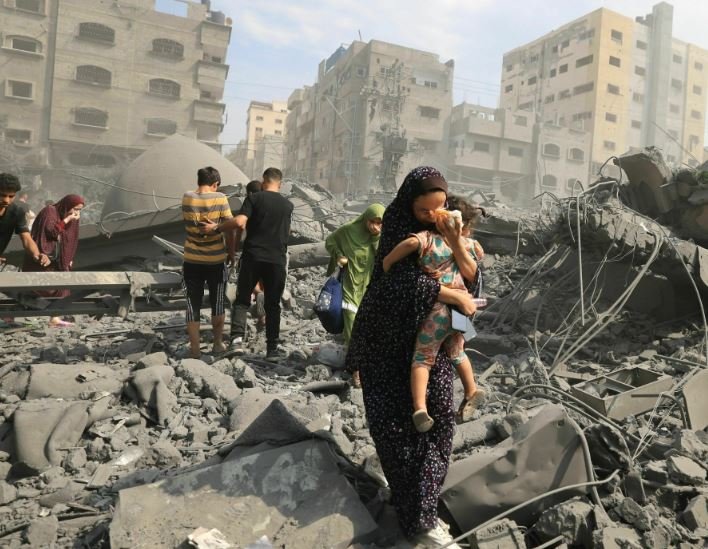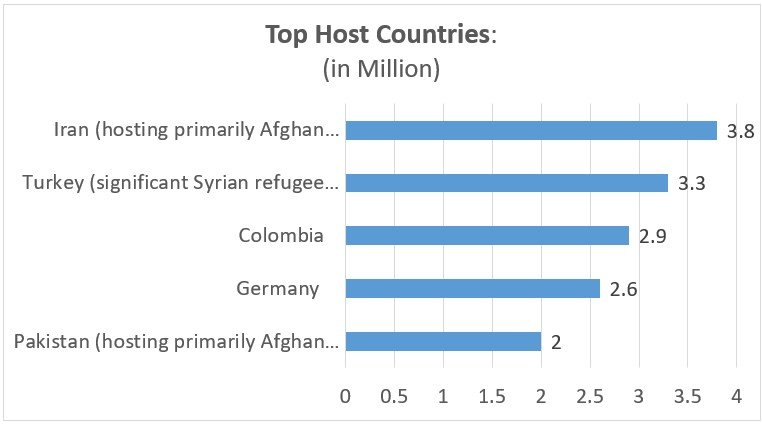World Refugee Day 2024 marks a sobering milestone as the global refugee population reaches an unprecedented high, surpassing 41 million individuals. The day, observed annually on June 20th, serves as a poignant reminder of the global plight faced by refugees. It is a day designated by the UN to raise awareness and garner support for those forcibly displaced worldwide.
Recent decades have seen significant escalations driven by geopolitical conflicts. The US-led invasions of Afghanistan (2001) and Iraq (2003), alongside civil wars in South Sudan and Syria, contributed to surpassing 30 million refugees by 2021. Ukraine and Sudan now face some of the fastest-growing refugee crises since World War II, with Ukraine alone witnessing 5.7 million fleeing within a year, primarily to neighboring nations such as Poland, Hungary, and Moldova.
You Can Also Read: FRESH DIPLOMACY MUST DELIVER FOR ROHINGYA REPATRIATION
A striking 72 percent of global refugees originate from just five countries: Afghanistan (6.4 million), Syria (6.4 million), Venezuela (6.1 million), Ukraine (6 million), and Palestine (6 million). These populations predominantly seek refuge in neighboring countries like Iran (3.8 million), Turkey (3.3 million), Colombia (2.9 million), Germany (2.6 million), and Pakistan (2 million). Iran and Pakistan host primarily Afghan refugees, while Turkey shelters a significant Syrian refugee population.
The Refugee Convention, established by the United Nations in 1951 in response to Europe’s post-World War II refugee crisis, initially protected 2.1 million refugees. Expanded globally in 1967, the Convention’s coverage reflected a growing global displacement crisis, with figures exceeding 10 million by 1980 and 20 million by 1990.

Top Countries of Origin (72% of global refugees):
- Afghanistan (6.4 million)
- Syria (6.4 million)
- Venezuela (6.1 million)
- Ukraine (6 million)
- Palestine (6 million)
Conflict in Sudan, Gaza, and DRC Drives Two-Thirds of New Global Displacements
Despite economic challenges, Lebanon, Jordan, Kenya, and Uganda host large numbers of refugees. Yemen, amidst internal conflict, saw migrant arrivals rise sharply from 27,000 in 2021 to over 90,000 in 2023. The International Organization for Migration estimates that 380,000 migrants in Yemen, seeking passage to Saudi Arabia and the Gulf States.
In contrast, Europe and North America, despite resources, have implemented restrictive measures that complicate asylum processes. The International Organization for Migration reported 4,114 deaths or disappearances in 2023 during dangerous crossings of the Mediterranean and Atlantic.

Globally, the UNHCR documented over 117.3 million forcibly displaced individuals in 2023, an 8 percent increase from 2022, projecting a rise to over 120 million by April 2024, continuing a 12-year trend of growing displacement due to conflicts, wars, and persecution.
Global displacement remains severe: 68.3 million internally displaced due to conflicts, with asylum seekers rising 30% to 5.4 million by 2022, per the IOM. Turkish asylum seekers in the EU surged 82% in 2023, exceeding 100,000 applications, despite a 75% rejection rate. US-Mexico border crossings by Turkish citizens spiked to 15,500 arrests from 1,400 in 2021.

Natural disasters displaced 7.7 million by 2023, with climate change exacerbating crises like Storm Daniel, which caused 4,000 fatalities in Libya alone. Globally, over 117 million individuals are forcibly displaced—more than the population of the Philippines—amid escalating conflicts, natural disasters, and climate impacts.
By the end of 2023, 68.3 million people were internally displaced globally, nearly double the figure from a decade ago. Sub-Saharan Africa hosts nearly half of all internally displaced persons (IDPs), largely due to conflicts receiving limited Western media coverage.
The Israeli bombardment of Gaza has displaced 1.7 million Palestinians, representing 75% of the Strip’s population, many displaced multiple times. Conflict in Sudan, Gaza, and the Democratic Republic of the Congo (DRC) caused nearly two-thirds of new displacements. Sudan alone saw 10.8 million people displaced by the end of 2023, marking one of the highest figures recorded in a single country.
Internal Displacement Rises: Urbanization, Economic Factors Cited
Human suffering on an unprecedented scale persists amidst inadequate international funding for humanitarian relief. Despite global military spending reaching $2.4 trillion in 2023, only $24 billion was secured for humanitarian aid—just 43% of what’s needed to assist millions of displaced individuals.
The media largely overlooks these stark realities, as wars, conflicts, and disasters continue to uproot millions, normalized as acceptable policy by powerful nations and their allies. Currently, one in 69 people worldwide is displaced: 68 million internally, 43.4 million refugees, and 6.9 million asylum seekers seek urgent assistance according to the UNHCR.
Current displacement trends underscore the multifaceted drivers behind population movements. The Internal Displacement Monitoring Centre identifies factors such as rapid urbanization, economic development, and environmental hazards as significant contributors. Specifically, escalating conflicts in regions like Tigray, Afghanistan, and Burkina Faso, coupled with challenges like food scarcity, inflation, and the climate crisis, continue to propel displacement globally.
Climate change, notably labeled by UNHCR as the defining crisis of our era, intensifies disaster-induced displacement. Since 2008, an average of 21.5 million people annually have been displaced by weather-related events alone. Looking ahead, the Institute for Economics & Peace warns that over one billion people could face displacement by 2050 due to environmental degradation, conflict, and civil unrest, underscoring the urgency for comprehensive global responses.
Global Displacement Statistics
- 68 million internally displaced persons (IDPs)
- 43.4 million refugees
- 6.9 million asylum seekers
Amidst these challenges, there are proactive efforts. The World Bank emphasizes tailored solutions that address the specific needs of displaced communities, focusing on sustainable development and job creation. The Global Compact on Refugees, established in 2018, advocates for enhancing refugees’ ability to rebuild their lives with dignity, aiming ultimately for sustainable peace in conflict zones to facilitate safe returns.
Wealthy Nations Lag as Middle-Income Countries Shoulder Burden
The global landscape of refugee support and policies reflects a stark contrast between the responsibilities assumed by poorer, middle-income, and wealthier nations. While some affluent countries have historically made substantial contributions, the burden disproportionately falls on poorer nations, with some middle-income countries playing critical roles despite facing significant challenges. Lebanon and Turkey, for instance, stand out for their considerable efforts in hosting large numbers of refugees, underscoring the potential for middle-income countries to elevate global responsibility-sharing.
However, the involvement of more populous middle-income countries like China, India, Indonesia, and Brazil remains pivotal. These nations have experienced robust economic growth in recent decades, thereby reducing the validity of financial constraints as a rationale for limited refugee support.
The United States’ refugee resettlement policies shifted significantly under the Trump administration, sharply reducing admissions. President Biden’s commitment to increase refugee admissions signals a potential return to more compassionate policies, yet political pressures impact US-Mexico border asylum practices.
In Europe, nations respond to migration pressures with restrictive measures, exemplified by Denmark’s Syrian repatriation and the UK’s Rwanda agreement, echoing Australia’s tough immigration stance. Eastern European countries like Poland, Latvia, and Lithuania reinforce borders amid geopolitical tensions, exacerbating EU periphery crises.
Sweden and Germany, once generous, adjust asylum policies amid domestic pressures, restricting family reunification and humanitarian admissions. Refugee-hosting countries like Lebanon, Jordan, and Turkey face internal strains amid limited opportunities and societal tensions, as global humanitarian aid fails to match rising needs, emphasizing the need for enhanced global solidarity and financial support.
Rohingya Crisis Fades from Global Spotlight
Amidst global crises and shifting humanitarian priorities, the Rohingya crisis that began in 2017 has largely faded from international focus. Seven years since fleeing Myanmar to Cox’s Bazar, Bangladesh, Rohingya refugees endure dire conditions in makeshift camps reliant on relief aid. Youth in the camps face idleness and limited opportunities, missing out on normal experiences.
In 2023, the Joint Response Plan for the Rohingya received 65.2% of its USD 876 million appeal, marking it as one of the best-funded refugee response plans globally. The international community demonstrated solidarity with Rohingya refugees and their host country through record pledges made at the December 2023 Global Refugee Forum in Geneva.
However, recent months have been particularly harsh, with nearly one million Rohingya enduring extreme heat waves, two devastating fires, and a cyclone. Fires destroyed shelters, exposing many to the elements, while heat forced them into stifling tarpaulin-covered dwellings.
Women and adolescent girls endure severe challenges, with over 80% facing gender-based violence and pervasive fears of insecurity. Child marriage persists amid limited access to justice.
World Refugee Day on June 20, 2024, themed ‘Solidarity with Refugees’, urges actionable support beyond rhetoric. Amidst global crises, solidarity with refugees like the Rohingya communities demands a renewed commitment to uphold their rights, dignity, and voices amidst formidable adversity.


